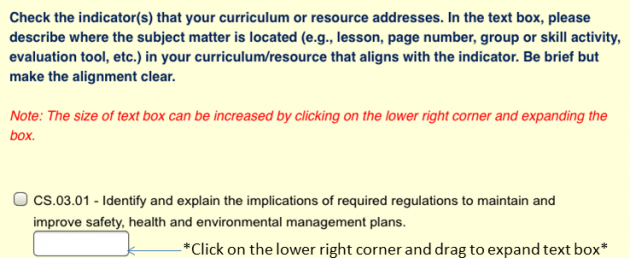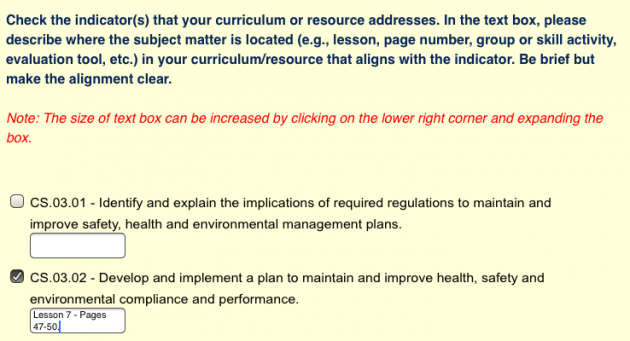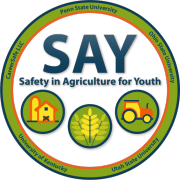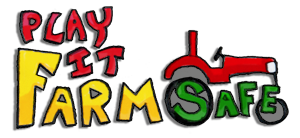The Safety in Agriculture for Youth project (SAY) is compiling a national clearinghouse of materials for agricultural safety and health education. The SAY Curriculum Alignment Submission Tool (CAST) is an online instrument that participants use to submit an agricultural safety and health Formal Curriculum or Other Supporting Resource to SAY for possible inclusion in the national clearinghouse. Note: Explanations of the terms Formal Curriculum and Other Supporting Resource are included in the “Providing Submitter and Submission Information” section below. For convenience, these official terms are replaced by the term curriculum/other resource in most places in CAST and in these directions.
Materials submitted should align in some part with the Agriculture, Food and Natural Resources (AFNR) Career Cluster Content Standards promoted by the National Council for Agricultural Education and the National FFA Foundation. A currently existing curriculum/other resource may not align closely to these standards because the standards are relatively new to the agricultural safety and health community. However, even a curriculum/other resource with a low level of alignment can be a valuable educational resource for the SAY National Clearinghouse. Those not familiar with the AFNR Career Cluster Content Standards are strongly advised to study them thoroughly before submitting a curriculum/other resource. If your curriculum/other resource aligns with AFNR Career Cluster Content Standard(s), it will be added to the SAY National Clearinghouse and assigned high, medium, or low alignment. The alignment is based on the information that you provide in your submission so please be clear and concise. The following definitions outline the three alignment categories:
High Alignment—The curriculum/other resource aligns very well with this component of the Performance Indicator.
Medium Alignment—The curriculum/other resource has a moderate degree of alignment with this component of the Performance Indicator.
Low Alignment—The curriculum/other resource does not align well with this component of the Performance Indicator, but enough common language is involved to conclude that some alignment exists.
Before you begin the submission process, click HERE to open the latest version of the safety related AFNR Career Cluster Content Standards, Performance Indicators and Measurements. Print a copy so you can refer to it when completing your submission. This document will help you compare the objectives, goals or outcomes of your curriculum/other resource with those of AFNR. You will notice three shades of green (or gray). The darker shade is the Common Career Technical Core Standards. These are the broadest level of standards, and ultimately what your curriculum/other resource will align to. You will notice that these are very broad statements so more specific statements are listed below these. The middle shade is the ‘Indicators’. When you actually submit your information in the submission template, you will be submitting under the appropriate Indicators. Because these too are very broad, you will notice various statements below each indicator. These are the lightest shade. These measurements are examples of standards under the specific indicators. To us, it makes sense to compare your curriculum/other resource objectives and activities with these statements, because they are more specific.
As you compare your objectives and activities with the AFNR measurements, we suggest making a note of the lesson/page number(s)/activity that relate to the AFNR measurement. You may find that there are multiple activities that together will meet some measurements. For example, participants may need to complete a group or skills activity and/or correctly answer evaluation questions. You will be asked to enter this information on the CAST.
Once you feel that your program’s objectives come close to these examples, you are ready to start filling in the submission template (CAST). After printing these directions, click HERE to access CAST to submit your curriculum/other resource.
Providing Submitter and Submission Information
In the first part of CAST, you will provide information about the submitting organization and the materials to be submitted. The explanations that follow will help you complete this task.
Name of Submitter: Name of the person submitting the curriculum/other resource. This person should be an author or someone working with the author(s).
Name of Organization: Name of the organization that created and/or published the curriculum/other resource.
Email Address: Email address of the person making the submission.
Phone: Phone number for the person making the submission.
Title of Educational Resource: Name of the curriculum/other resource being submitted.
Type of Submission: Choose Formal Curriculum or Other Supporting Resource by clicking the appropriate button. Choose only one option. The term Formal Curriculum refers to material that: 1) has learning goals or objectives that are clearly stated; 2) includes subject matter content supportive of the learning goals or objectives; and 3) has an evaluation component (for example, some type of student assessment, such as a quiz). The term Other Supporting Resource refers to more individualized, originally authored resources, such as technical fact sheet series, video clips, PowerPoint presentations, or other materials that lack one or more of the three elements of a Formal Curriculum. Both types of materials may be supportive of AFNR Career Cluster Content Standards and can be valuable educational materials for youth agricultural safety and health.
Date Published/Latest Revision: Materials should have been authored or revised within the past 10 years.
Check the format of the curriculum/other resource you are submitting: Choose the best description of the format of the curriculum/other resource. If the curriculum/other resource is available only in hard-copy form, choose hard copy. If an electronic version is available, choose online/electronic. If the curriculum/other resource is available electronically, provide a link in the Describe how others can access this curriculum/other resource item in this part of the submission tool (described below). If the curriculum/other resource is available in hard-copy form only, mail a copy to Davis Hill, 204B Agricultural Engineering Building, University Park, PA 16802.
Describe in a sentence or two the curriculum/other resource being submitted: Provide a couple of sentences that describe the curriculum/other resource. Include information such as training type (for example, online training, in-person training, field day, and so on); intended length of the program; and unique aspects of the curriculum/other resource.
Check the age group(s) of the target audience: Choose all age groups that apply for the target audience of the curriculum/other resource.
List the learning goals, objectives, or outcomes of the curriculum/other resource: Provide the learning goals/objectives/expected outcomes for the curriculum/other resource.
Describe the testing/evaluation component(s) of the curriculum/other resource: Provide a brief description of the testing/evaluation component of the curriculum/other resource. If there is no testing or evaluation component because the material is an Other Supporting Resource submission, type “Not Applicable.”
Describe how others can access the curriculum/other resource: Provide a brief explanation of how people can access the curriculum/other resource. For example, state that the curriculum/other resource is available online through a university, and provide the applicable website.
After you have entered the required information about the submitter and the submission, click the forward arrow to continue to the part of CAST in which you will provide information about how your materials align with the AFNR Common Career Technical Core Standards. CAUTION: Use only the forward and back arrows at the bottom right of the screen to navigate within CAST (Figure 1). Do not use the browser arrows (if you do so, your information may be lost).

Fig. 1. Forward and back arrows on the CAST screen.
Completing the Self-Assessment of Alignment to AFNR Standards
The Curriculum Alignment Committee and SAY team members have identified the AFNR Career Cluster Content Standards that include agricultural safety and health Indicators and Measurements. For each relevant standard, CAST presents a block of questions you will use to supply information about the alignment of your materials to the standard. The block of questions is the same for each standard. The steps that follow provide information for completing the self-assessment of alignment to the standards.
- The first question asks whether your curriculum/other resource aligns with a specific Common Career Technical Core Standard. (Figure 2). Answer by choosing Yes or No. If you answer “Yes,” the next question in the block for the specified Common Career Technical Core Standard displays. If you answer “No,” the first question for the next Common Career Technical Core Standard displays.

Fig. 2. Example of the first question in each block.
- After indicating that your curriculum/other resource aligns to the specified Common Career Technical Core Standard, identify the particular Performance Indicator(s) with which your curriculum/other resource aligns. Each Performance Indicator for the specified Common Career Technical Core Standard is listed with a corresponding check box (Figure 3). Your curriculum/other resource might align with multiple Performance Indicators, so choose all that apply.

Fig. 3. Example of Indicators.
For each indicator that you check, you will need to indicate where the subject matter is located in your curriculum/resource that aligns with the indicator. Type this information in the text box below each of the indicator(s) and note that the size of the text box can be increased by clicking on the corner and expanding the box. We suggest referring to the sample measurements in the downloaded document to help decide which specific indicator to list your material. It would be most helpful to us if you listed the sample measurement number with your submission. For example, in Figure 4, we have listed Lesson 7, pgs. 47-50 under CS.03.02 to say that the curriculum being submitted relates somewhat to measurements under this indicator and this can be found in Lesson 7 (on pages 47-50) of the submitted curriculum. That would make it easy for us to find and confirm.

Figure 4. Stating location indicator is addressed in your curriculum/resource.
Thank you for submitting your curriculum/other resource for possible inclusion in the SAY National Clearinghouse. If you have questions about the curriculum/other resource submission process, contact Dave Hill at deh27@psu.edu or (814) 865-2808.
Summarized and reviewed by:
Kirby Barrick, University of Florida
Davis E. Hill, Penn State University (has since retired)
Dennis J. Murphy, Penn State University (has since retired)
Ben Swan, California Polytechnic State University (San Luis Obispo)
Brian Warnick, Utah State University









